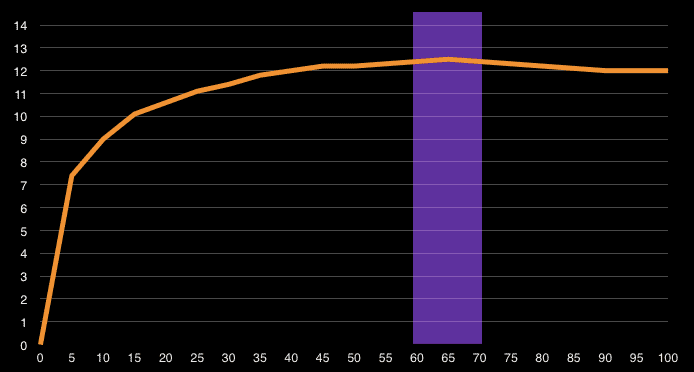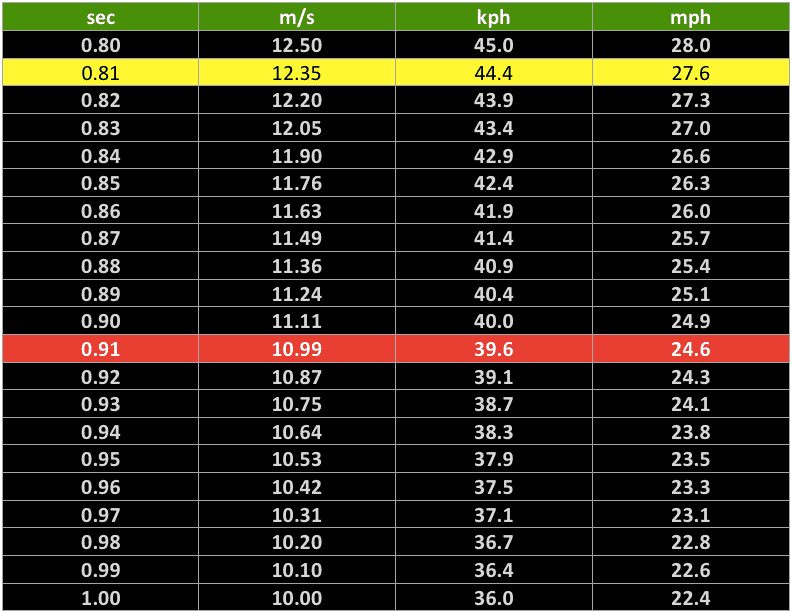
How fast is Usain Bolt?
The purest question one can ask in sports is about how fast someone can run. For competition purposes, the 100-meter dash at the Olympics is an event that attempts to answer that question. Unfortunately, the time at the end of the race only shares how long it takes to get there and does not reveal an athlete’s maximum velocity. In 2009, Usain Bolt ran the world-record time of 9.58 seconds. Not only was that race in Berlin one of the greatest ever, it was the fastest recorded speed a human being has ever run in any conditions. Many sports fans want to know not only how fast Usain Bolt ran but also how fast other athletes are relative to the greatest living sprinter.
Analysis of the 2009 World Record
On August 16, 2009, Usain Bolt ran 100 meters in 9.58 seconds with a +0.9 wind, a world record and the fastest a human has ever run. When we talk about how fast someone is, many different interpretations can be suggested, but most people look at maximal speed and not event speed. Each distance run has a unique time, but all events have a maximal velocity that can be calculated. When we glance at our dashboard while driving, the current speed in terms of miles per hour or kilometers per hour is displayed, and we can calculate those speeds by breaking down the Usain Bolt sprint. It is essential to know that to reach maximal velocity, humans need at least 60 meters of distance to accelerate to top speed. The 40 yard dash is a measure of acceleration, and while it’s more likely to be useful for team sports, many team sport athletes run fast enough to make the longer sprints needed to clock how fast they can run. The 100m dash is long enough that fatigue hits at the very end of the race, but no sprinter is saving energy by not running maximal speed.

Figure 1: The velocity and distance chart for Usain Bolt’s 2009 100m race in Berlin. Note the distance (horizontal axis) and the velocity in meters per second (vertical axis) showing top speed at the 60-70m race segment.
Usain Bolt reached his top velocity at approximately 60 meters as shown in the figure above. The X axis is the race distance with 5 meter intervals. To smooth out the data, 5 meter intervals or 2-3 steps enhances precision and better helps visualize the race. The Y axis is velocity in meters per second, a natural pairing to the distance horizontally. In track and field, all distances are metric, and velocity is described by sharing how fast one is going per second by listing the precise distance in meters. For simplicity, a 100-meter race is usually broken down into 10-meter segments, the approach we will use here to make the numbers easier to work with. After we break down the race in more detail and get the final speed, we will then convert the metric time into imperial units for American readers but list all units for deeper understanding.
Peak velocity is hit somewhere between 60 and 70 meters into the race, and sport scientists use videos and sometimes laser equipment to estimate speed. In athletics (track and field), all the scientists have for the most part is a video and the chronometer that is synced with the digital film. Using tools similar to Dartfish and other video analysis software, experts in biomechanics break down the race into 10-meter increments and the time it takes to get to each part of the race. Conveniently, the race is 100 meters, so slicing up the sprint into ten segments is nice and neat from a mathematical standpoint. From a quick look at the chart, one can see that the early part of the race takes longer as it’s slower, but at the three quarter mark Usain Bolt, like most sprinters, reaches maximum velocity. To acquire top speed, as most do in sprint races, the approach is to see how long it takes to get from point A to point B, specifically the fastest part. It’s believed that, in most races, athletes can only hold their max speed for a few steps; a 10 meter segment is long enough to represent what an athlete can hold, but not so long that slower steps will decrease their average speed in the segment. One can drill down to the fastest step in the race, but the difference between the fastest step and the next few are so small it’s not worth it. In summary, top speed is only held for a very brief time, but 10m is adequate to prevent misrepresentation.
Converting Splits to Maximum Speed
The fastest split for a flying 10m segment ever attained is estimated to be 0.81 seconds, attained by Usain Bolt during the finals. The conditions of the race were historical, since the previous year Tyson Gay had been injured, and all three fastest men in the world were lined up for an epic showdown. To most sprint coaches who live in a world of splits and other forms of race analysis, the 0.81 did not require a second thought to appreciate the speed Usain attained in the finals. Splits are common numbers seen time after time with coaches, but to the average person, the only splits are laps around a 400-meter track for pacing. A 10-meter segment is a little different. When converting from a 10-meter split to meters per second, the math isn’t hard, but most want to know how many miles or kilometers per hour someone can go. We are all familiar with automobile velocities from speedometers, and modern bikes and even GPS tools with smartphones provide real-time speed. Most sports are starting to get into more athlete data, and players are tracked in either kph or mph using video or GPS sensor data.

Figure 2: The split velocity chart is a conversion table for all coaches, not just track coaches, to see familiar speeds athletes can achieve. The faster the athlete, the more distance they need and the further the transmitters if using Freelap timing. The yellow line is what Usain Bolt is capable of doing, and the red line is a speed barrier that, so far, nobody in soccer has broken. Remember that game situations, surfaces, fatigue, and other factors limit what athletes can do in games.
The table is a perfect way for coaches to not only see maximum speed but also create fitness profiles and other conditioning metrics based on how much speed someone can maintain. For the purposes of this article, Usain Bolt hit roughly 27.6 miles per hour, or 44.4 kilometers per hour if you are reading from somewhere outside the USA. Another perspective can be taken by measuring out 12.35 meters, and that is how much ground Usain covered in one second, or just a blink of the eye. Everything is relative, though; as impressive as Usain Bolt is, we humans are not fast runners compared to other land animals, and from the interview with Bill Pressey, one can deduce that we are slow animals. We are not as fast as other two-legged creatures such as the ostrich and kangaroos, but we are a rare species in that we are mammals that use two-legged locomotion.
Parting Thoughts
How fast athletes can run is fascinating, and Usain Bolt’s speed is the fastest anyone has run in any conditions. As mentioned earlier, wind that is too fast from behind is considered illegal, as just a stiff breeze greater than 2.0 meters per second will prevent a track event not able to from being considered for a record. In the past, races that were significantly wind aided resulted in times that appeared to be fantasy, such as the race in El Paso in which Obadele Thompson ran a 9.69, a performance worthy of science fiction. Years later, Usain Bolt shattered that barrier and ran an 0.81 within the legal limits for wind, becoming the world’s fastest man. What will it take to run faster? The Freelap Receiver is set for 0.78, as we think it impossible for an athlete to run faster during practice in the near future—but who knows what can be done with talent and hard work.
Excel Spreadsheet
Coaches and athletes interested in converting splits to velocities can download this excel file for speed estimation of conditioning and other calculations.
Please share so others may benefit.
[mashshare]


Great article!
The app I use to time 10+ splits from a video – and save them on the screen – is the iPhone/iPad app: CoachMyVideo+
The free version of CoachMyVideo includes a free trial of the split-timing and saving of those times.
http://iTunes.CoachMyVideo.com
Full Disclosure, I’m the dev and recently added this split timing feature. Email me via the app if you have any more ideas / feedback about this feature.